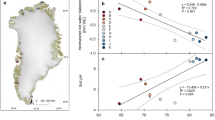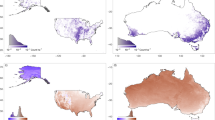Abstract
Methane is an important greenhouse gas and its atmospheric concentration has almost tripled since pre-industrial times1,2. It plays a central role in atmospheric oxidation chemistry and affects stratospheric ozone and water vapour levels. Most of the methane from natural sources in Earth's atmosphere is thought to originate from biological processes in anoxic environments2. Here we demonstrate using stable carbon isotopes that methane is readily formed in situ in terrestrial plants under oxic conditions by a hitherto unrecognized process. Significant methane emissions from both intact plants and detached leaves were observed during incubation experiments in the laboratory and in the field. If our measurements are typical for short-lived biomass and scaled on a global basis, we estimate a methane source strength of 62–236 Tg yr-1 for living plants and 1–7 Tg yr-1 for plant litter (1 Tg = 1012 g). We suggest that this newly identified source may have important implications for the global methane budget and may call for a reconsideration of the role of natural methane sources in past climate change.
This is a preview of subscription content, access via your institution
Access options
Subscribe to this journal
Receive 51 print issues and online access
$199.00 per year
only $3.90 per issue
Buy this article
- Purchase on Springer Link
- Instant access to full article PDF
Prices may be subject to local taxes which are calculated during checkout


Similar content being viewed by others
References
Lelieveld, J., Crutzen, P. J. & Dentener, F. J. Changing concentration, lifetimes and climate forcing of atmospheric methane. Tellus B 50, 128–150 (1998)
Houghton, J. T. et al. (eds) Climate Change 2001: The Scientific Basis (Cambridge Univ. Press, Cambridge, 2001)
Bartlett, K. B. & Harriss, R. C. Review and assessment of methane emissions from wetlands. Chemosphere 26, 261–320 (1993)
Dlugokencky, E. J., Masarie, K. A., Lang, P. M. & Tans, P. P. Continuing decline in the growth rate of the atmospheric methane burden. Nature 393, 447–450 (1998)
Walter, B. P., Heimann, M. & Matthews, E. Modeling modern methane emissions from natural wetlands 2. Interannual variations 1982–1993. J. Geophys. Res. 106, 34207–34219 (2001)
Houweling, S., Dentener, F., Lelieveld, J., Walter, B. & Dlugokencky, E. The modeling of tropospheric methane: How well can point measurements be reproduced by a global model? J. Geophys. Res. 105, 8981–9002 (2000)
Lowe, D. C. et al. Concentration and 13C records of atmospheric methane in New Zealand and Antarctica—Evidence for changes in methane sources. J. Geophys. Res. 99, 16913–16925 (1994)
Quay, P. et al. The isotopic composition of atmospheric methane. Glob. Biogeochem. Cycles 13, 445–461 (1999)
Frankenberg, C., Meirink, J. F., van Weele, M., Platt, U. & Wagner, T. Assessing methane emissions from global space-borne observations. Science 308, 1010–1014 (2005)
Keppler, F., Kalin, R. M., Harper, D. B., McRoberts, W. C. & Hamilton, J. T. G. Dramatic 13C depletion in the plant methoxyl pool and its biogeochemical implications. Biogeosciences 1, 123–131 (2004)
Hamilton, J. T. G., McRoberts, W. C., Keppler, F., Kalin, R. M. & Harper, D. B. Chloride methylation by plant pectin: An efficient environmentally significant process. Science 301, 206–209 (2003)
Keppler, F., Harper, D. B., Röckmann, T., Moore, R. M. & Hamilton, J. T. G. New insight into the atmospheric chloromethane budget gained using stable carbon isotope ratios. Atmos. Chem. Phys. 5, 2403–2411 (2005)
Saugier, B., Roy, J. & Mooney, H. A. in Global Terrestrial Productivity (eds Roy, J., Saugier, B. & Mooney, H. A.) 541–555 (Academic, San Diego, 2001)
Gogoi, N., Baruah, K. K., Gogoi, B. & Gupta, P. K. Methane emission characteristics and its relations with plant and soil parameters under irrigated rice ecosystem of northeast India. Chemosphere 59, 1677–1684 (2005)
Sass, R. L. & Cicerone, R. J. Photosynthate allocations in rice plants: Food production or atmospheric methane? Proc. Natl Acad. Sci. USA 99, 11993–11995 (2002)
FAO, Global Forest Resources Assessment 2000—Main Report (FAO Forestry Paper No. 140, Food and Agriculture Organization of the United Nations, Rome, 2001)
Dlugokencky, E. J. et al. Atmospheric methane levels off: Temporary pause or a new steady-state? Geophys. Res. Lett. 30 doi:10.1029/2003GL018126 (2003)
Mayle, F. E., Beerling, D. J., Gosling, W. D. & Bush, M. B. Responses of Amazonian ecosystems to climatic and atmospheric carbon dioxide changes since the last glacial maximum. Phil. Trans. R. Soc. Biol. Sci. 359, 499–514 (2004)
Petit, J. R. et al. Climate and atmospheric history of the past 420,000 years from the Vostok ice core, Antarctica. Nature 399, 429–436 (1999)
Ferretti, D. et al. Unexpected changes to the global methane budget over the past 2000 years. Science 309, 1714–1717 (2005)
Lassey, K. R., Lowe, D. C. & Manning, M. R. The trend in atmospheric methane δ13C implications for isotopic constraints on the global methane budget. Glob. Biogeochem. Cycles 14, 41–49 (2000)
Houweling, S., Dentener, F. & Lelieveld, J. Simulation of preindustrial atmospheric methane to constrain the global source strength of natural wetlands. J. Geophys. Res. 105, 17243–17255 (2000)
Cramer, W. et al. Global response of terrestrial ecosystem structure and function to CO2 and climate change: results from six dynamic global vegetation models. Glob. Change Biol. 7, 357–373 (2001)
Acknowledgements
We thank R. Conrad, J. Kesselmeier and D. Harper for comments on the manuscript; B. Knape, P. Franz, R. Shaheen, F. Kleinbongardt, V. Mallinger, R. Runck and C. McRoberts for technical assistance; the Botanical Garden of the University of Heidelberg for providing plant species from tropical regions; and the European Commission for a Marie Curie-Research Training Grant (F.K.). The ISOSTRAT project in Heidelberg was funded by the BMBF within the AFO2000 project.
Author information
Authors and Affiliations
Corresponding author
Ethics declarations
Competing interests
Reprints and permissions information is available at npg.nature.com/reprintsandpermissions. The authors declare no competing financial interests.
Supplementary information
Supplementary Notes
This file contains Supplementary Tables 1 and 2, and Supplementary Figures 1–4. (DOC 127 kb)
Rights and permissions
About this article
Cite this article
Keppler, F., Hamilton, J., Braß, M. et al. Methane emissions from terrestrial plants under aerobic conditions. Nature 439, 187–191 (2006). https://doi.org/10.1038/nature04420
Received:
Accepted:
Issue Date:
DOI: https://doi.org/10.1038/nature04420
This article is cited by
-
Greenhouse gas levels (CH4 and CO2) in Lagos state and Oyo state, Nigeria
Discover Environment (2024)
-
Floating macrophyte phyllosphere as a habitat for methanogens
Environmental Chemistry Letters (2024)
-
Methane formation driven by light and heat prior to the origin of life and beyond
Nature Communications (2023)
-
Tree Foliage is a Methane Sink in Upland Temperate Forests
Ecosystems (2023)
Comments
By submitting a comment you agree to abide by our Terms and Community Guidelines. If you find something abusive or that does not comply with our terms or guidelines please flag it as inappropriate.



